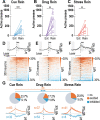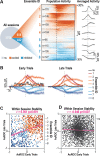This is a preprint.
Corticostriatal ensemble dynamics across heroin self-administration to reinstatement
- PMID: 38979314
- PMCID: PMC11230161
- DOI: 10.1101/2024.06.21.599790
Corticostriatal ensemble dynamics across heroin self-administration to reinstatement
Abstract
Corticostriatal projection neurons from prelimbic medial prefrontal cortex to the nucleus accumbens core critically regulate drug-seeking behaviors, yet the underlying encoding dynamics whereby these neurons contribute to drug seeking remain elusive. Here we use two-photon calcium imaging to visualize the activity of corticostriatal neurons in mice from the onset of heroin use to relapse. We find that the activity of these neurons is highly heterogeneous during heroin self-administration and seeking, with at least 8 distinct neuronal ensembles that display both excitatory and inhibitory encoding dynamics. These neuronal ensembles are particularly apparent during relapse, where excitatory responses are amplified compared to heroin self-administration. Moreover, we find that optogenetic inhibition of corticostriatal projection neurons attenuates heroin seeking regardless of the relapse trigger. Our results reveal the precise corticostriatal activity dynamics underlying drug-seeking behaviors and support a key role for this circuit in mediating relapse to drug seeking.
Conflict of interest statement
Competing Interests The authors have no competing interests to declare.
Figures




Similar articles
-
Restoration of a paraventricular thalamo-accumbal behavioral suppression circuit prevents reinstatement of heroin seeking.Neuron. 2024 Mar 6;112(5):772-785.e9. doi: 10.1016/j.neuron.2023.11.024. Epub 2023 Dec 22. Neuron. 2024. PMID: 38141605 Free PMC article.
-
Increased Excitability and Synaptic Plasticity of Drd1- and Drd2-Expressing Prelimbic Neurons Projecting to Nucleus Accumbens after Heroin Abstinence Are Reversed by Cue-Induced Relapse and Protein Kinase A Inhibition.J Neurosci. 2023 May 31;43(22):4019-4032. doi: 10.1523/JNEUROSCI.0108-23.2023. Epub 2023 Apr 24. J Neurosci. 2023. PMID: 37094933 Free PMC article.
-
Divergent Prelimbic Cortical Pathways Interact with BDNF to Regulate Cocaine-seeking.J Neurosci. 2018 Oct 17;38(42):8956-8966. doi: 10.1523/JNEUROSCI.1332-18.2018. Epub 2018 Sep 5. J Neurosci. 2018. PMID: 30185459 Free PMC article.
-
Corticostriatal plasticity, neuronal ensembles, and regulation of drug-seeking behavior.Prog Brain Res. 2017;235:93-112. doi: 10.1016/bs.pbr.2017.07.013. Epub 2017 Oct 12. Prog Brain Res. 2017. PMID: 29054293 Free PMC article. Review.
-
Neurobiology of relapse to heroin and cocaine seeking: a review.Pharmacol Rev. 2002 Mar;54(1):1-42. doi: 10.1124/pr.54.1.1. Pharmacol Rev. 2002. PMID: 11870259 Review.
Cited by
-
Opioidergic tuning of social attachment: reciprocal relationship between social deprivation and opioid abuse.Front Neuroanat. 2025 Jan 23;18:1521016. doi: 10.3389/fnana.2024.1521016. eCollection 2024. Front Neuroanat. 2025. PMID: 39917739 Free PMC article. Review.
References
Publication types
Grants and funding
- T32 AA007474/AA/NIAAA NIH HHS/United States
- F32 DA053830/DA/NIDA NIH HHS/United States
- R01 DA054271/DA/NIDA NIH HHS/United States
- I01 BX006179/BX/BLRD VA/United States
- TL1 TR001451/TR/NCATS NIH HHS/United States
- R01 AA030796/AA/NIAAA NIH HHS/United States
- R01 DA049711/DA/NIDA NIH HHS/United States
- UL1 TR001450/TR/NCATS NIH HHS/United States
- T32 DA007288/DA/NIDA NIH HHS/United States
- K99 DA058049/DA/NIDA NIH HHS/United States
- R01 DA054154/DA/NIDA NIH HHS/United States
- R25 GM113278/GM/NIGMS NIH HHS/United States
- F32 DA057794/DA/NIDA NIH HHS/United States
- F31 DA052186/DA/NIDA NIH HHS/United States
- R01 DA051650/DA/NIDA NIH HHS/United States
LinkOut - more resources
Full Text Sources
